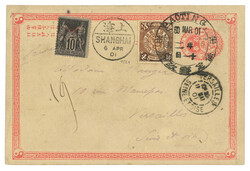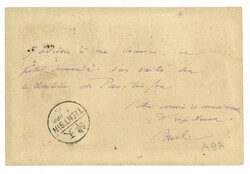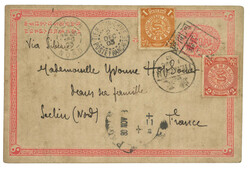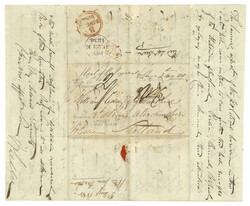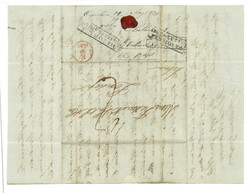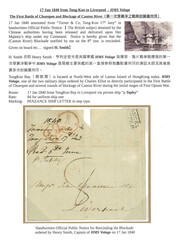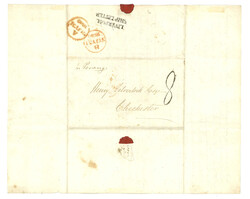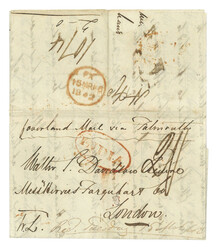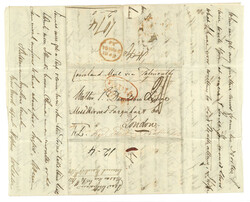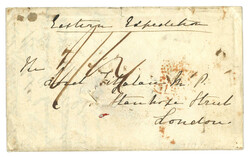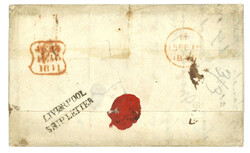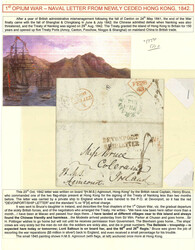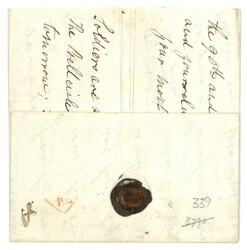1842 (23 Oct) A Good Historic Dispatch from Hong Kong to Ireland On
Board H.M.S. Agincourt: Witness to the Aftermath of the Treaty
1842 (23 Oct) A Good Historic Dispatch from Hong Kong to Ireland On
Board H.M.S. Agincourt: Witness to the Aftermath of the Treaty of
Nanking Penned by Captain Henry Bruce aboard H.M.S. Agincourt,
anchored in the newly acquired British colony of Hong Kong, this
remarkable letter offers a firsthand account of the final chapters
of the First Opium War (1839–1842)—a conflict that reshaped
Sino-British relations and cemented Hong Kong’s fate as a Crown
Colony. A Commander’s Perspective: Captain Bruce was no ordinary
officer—he commanded one of the two flagship vessels present in
Hong Kong during the historic signing of the Treaty of Nanking (29
August 1842), which formally ended the war. His letter, written
just two months later, captures the immediate postwar transition:
the withdrawal of British forces, the logistical challenges of
occupation, and the human toll of tropical disease on European
troops. Postal Significance: A Rare Wartime Ship Letter • This
dispatch was not sent via official naval channels but entrusted to
a private vessel, later entering the British postal system at
Devonport. Its markings tell a story. • A striking red “DEVONPORT /
SHIP LETTER” handstamp, confirming its maritime routing. A
manuscript “8(p)” rate mark, indicating an unpaid ½-oz letter (8
pence due upon delivery)—unusual for military correspondence, which
typically enjoyed franking privileges. This suggests either urgency
or an informal dispatch method. A Glimpse into the Post-War Exodus;
Bruce’s words paint a vivid picture of the British withdrawal: “We
have now been here rather more than a month… The (HMS) Modeste
arrived yesterday from Sir William Parker at Chusan and goes home…
Sir Henry Pottinger [Hong Kong’s first Governor] wishes to return
but awaits Whitehall’s permission… The (HMS) Blenheim departs for
England soon. Our crews are dreadfully sickly—the men suffer but do
not die; the soldiers fare worse, perishing in great numbers. The
troopship Belleisle arrives shortly with Lord Saltoun and the 26th
& 98th Regiments…” A Lucrative Final Duty for Captain H. Bruce In a
telling postscript to the war, Bruce reveals his unexpected role:
escorting 5 million silver dollars (the first installment of
China’s $21 million indemnity under the Treaty) back to England—and
receiving a percentage for his troubles. A stark reminder of how
Britain’s victory was as much economic as it was military. Why This
Letter Matters” • Rarity: Few wartime letters from high-ranking
officers detail the Treaty’s immediate aftermath. • Postal
Hybridity: Its mix of private carriage and postal processing
reflects the ad-hoc systems of early colonial Hong Kong. • Human
Cost: Bruce’s notes on disease underscore why the British later
dubbed Hong Kong the “white man’s grave.” • A relic of empire, this
dispatch bridges naval history, postal evolution, and the grim
realities of colonial expansion.
1842年10月23日——一封從香港寄往愛爾蘭的重要歷史信函 阿金庫爾號戰艦上的見證:南京條約簽訂後的餘波
這封非凡的信件由亨利·布魯斯艦長在停泊於新獲得的英國殖民地香港的皇家戰艦「阿金庫爾號」上撰寫,提供了第一次鴉片戰爭(1839-1842年)最後階段的第一手記述——這場戰爭重塑了中英關係,並奠定了香港作為英國殖民地的命運。
指揮官布魯斯艦長絕非普通軍官——在1842年8月29日標誌性的《南京條約》簽署期間,他指揮了駐香港的兩艘旗艦之一,該條約正式結束了這場戰爭。他在兩個月後寫下的這封信,捕捉了戰後的過渡時期:英國軍隊的撤離、佔領期間的後勤挑戰,以及熱帶疾病對歐洲軍隊造成的人員損失。
郵政意義:一封罕見的戰時船郵信函 •
這封信件並非通過官方海軍渠道寄送,而是委託給私人船隻,後來在德文波特進入英國郵政系統。其郵戳標記訴說著一個故事。 •
紅色「DEVONPORT / SHIP
LETTER」手蓋郵戳,證實了其海上郵路。手寫的「8(p)」郵資標記,表明這是一封未付費的半盎司信件(需支付8便士郵資)——這在通常享有免郵特權的軍事通信中實屬罕見,暗示了寄件的緊迫性或非正式性。
戰後撤離的縮影:布魯斯的生動描述
「我們在此駐紮已逾月餘...(HMS)謙遜號昨日載著駐舟山的威廉·帕克爵士抵達並將返英...香港首任總督璞鼎查爵士渴望回國,但仍在等待白廳的許可...(HMS)布倫海姆號即將啟程返回英國。我們的船員健康狀況極差——士兵們飽受折磨但尚能倖存;陸軍士兵的情況更糟,死亡人數眾多。運兵船貝萊島號即將載著索爾頓勳爵及第26和第98步兵團抵達...」
布魯斯艦長的額外任務
在這場戰爭的尾聲,布魯斯透露了他意外獲得的任務:護送500萬銀元(根據條約中國賠款2,100萬美元的首期款項)返回英國——並因此獲得一定比例的酬勞。這鮮明地提醒著人們,英國的勝利不僅是軍事上的,更是經濟上的。
這封信件為何重要: • 稀有性:鮮有高級軍官的戰時信件能如此詳細地記錄條約簽訂後的直接影響。 •
郵政混合性:其私人運送與郵政處理的結合,反映了早期殖民時期香港的臨時郵政系統。 •
人力代價:布魯斯關於疾病的記錄,解釋了為何香港後來被英國人稱為「白人的墳墓」。 •
作為帝國時代的遺物,這封信件串聯了海軍歷史、郵政演變和殖民擴張的嚴酷現實。

